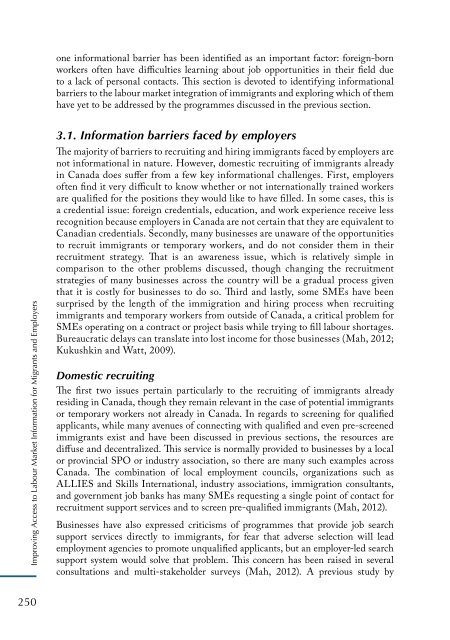International Organization for Migration (IOM)
International Organization for Migration (IOM)
International Organization for Migration (IOM)
Create successful ePaper yourself
Turn your PDF publications into a flip-book with our unique Google optimized e-Paper software.
Improving Access to Labour market In<strong>for</strong>mation <strong>for</strong> migrants and employers<br />
250<br />
one in<strong>for</strong>mational barrier has been identified as an important factor: <strong>for</strong>eign-born<br />
workers often have difficulties learning about job opportunities in their field due<br />
to a lack of personal contacts. This section is devoted to identifying in<strong>for</strong>mational<br />
barriers to the labour market integration of immigrants and exploring which of them<br />
have yet to be addressed by the programmes discussed in the previous section.<br />
3.1. In<strong>for</strong>mation barriers faced by employers<br />
The majority of barriers to recruiting and hiring immigrants faced by employers are<br />
not in<strong>for</strong>mational in nature. However, domestic recruiting of immigrants already<br />
in Canada does suffer from a few key in<strong>for</strong>mational challenges. First, employers<br />
often find it very difficult to know whether or not internationally trained workers<br />
are qualified <strong>for</strong> the positions they would like to have filled. In some cases, this is<br />
a credential issue: <strong>for</strong>eign credentials, education, and work experience receive less<br />
recognition because employers in Canada are not certain that they are equivalent to<br />
Canadian credentials. Secondly, many businesses are unaware of the opportunities<br />
to recruit immigrants or temporary workers, and do not consider them in their<br />
recruitment strategy. That is an awareness issue, which is relatively simple in<br />
comparison to the other problems discussed, though changing the recruitment<br />
strategies of many businesses across the country will be a gradual process given<br />
that it is costly <strong>for</strong> businesses to do so. Third and lastly, some SMEs have been<br />
surprised by the length of the immigration and hiring process when recruiting<br />
immigrants and temporary workers from outside of Canada, a critical problem <strong>for</strong><br />
SMEs operating on a contract or project basis while trying to fill labour shortages.<br />
Bureaucratic delays can translate into lost income <strong>for</strong> those businesses (Mah, 2012;<br />
Kukushkin and Watt, 2009).<br />
Domestic recruiting<br />
The first two issues pertain particularly to the recruiting of immigrants already<br />
residing in Canada, though they remain relevant in the case of potential immigrants<br />
or temporary workers not already in Canada. In regards to screening <strong>for</strong> qualified<br />
applicants, while many avenues of connecting with qualified and even pre-screened<br />
immigrants exist and have been discussed in previous sections, the resources are<br />
diffuse and decentralized. This service is normally provided to businesses by a local<br />
or provincial SPO or industry association, so there are many such examples across<br />
Canada. The combination of local employment councils, organizations such as<br />
ALLIES and Skills <strong>International</strong>, industry associations, immigration consultants,<br />
and government job banks has many SMEs requesting a single point of contact <strong>for</strong><br />
recruitment support services and to screen pre-qualified immigrants (Mah, 2012).<br />
Businesses have also expressed criticisms of programmes that provide job search<br />
support services directly to immigrants, <strong>for</strong> fear that adverse selection will lead<br />
employment agencies to promote unqualified applicants, but an employer-led search<br />
support system would solve that problem. This concern has been raised in several<br />
consultations and multi-stakeholder surveys (Mah, 2012). A previous study by


